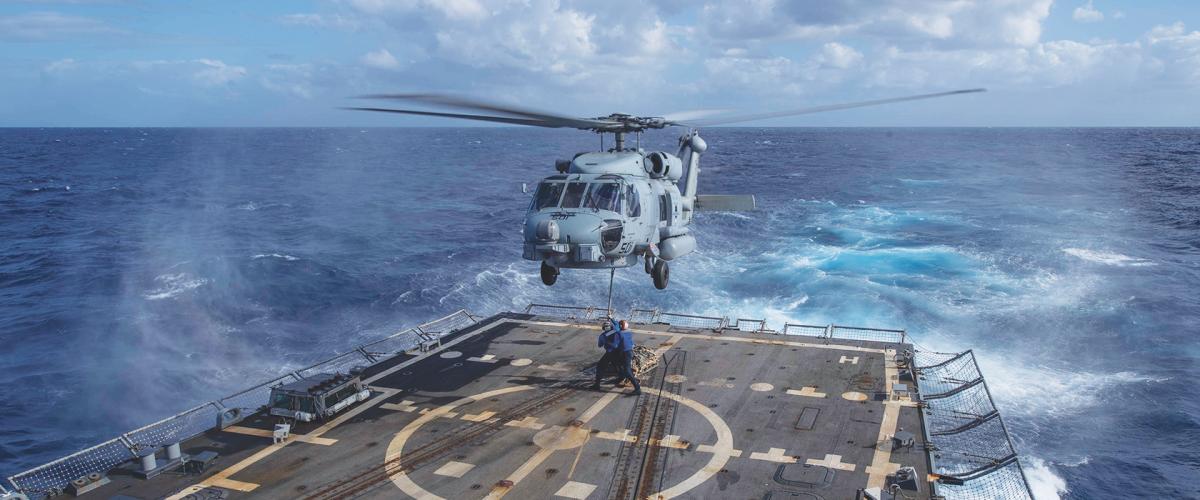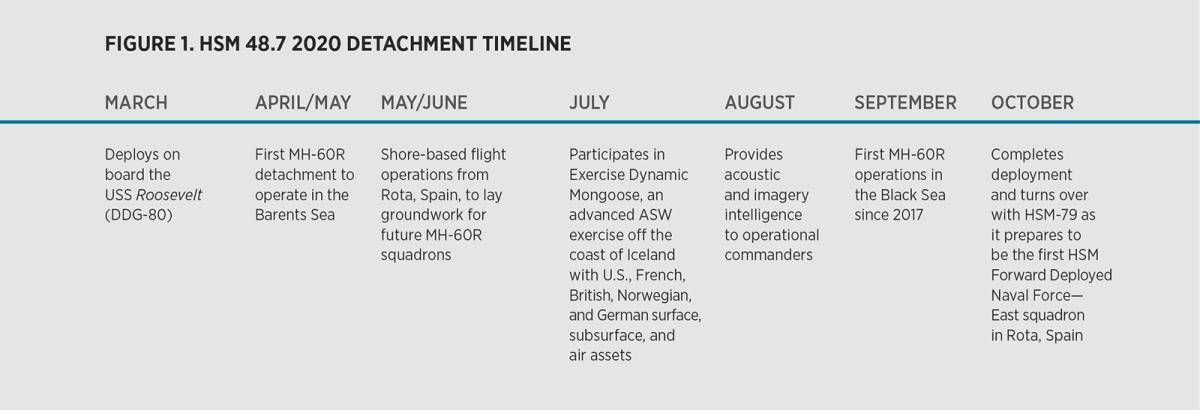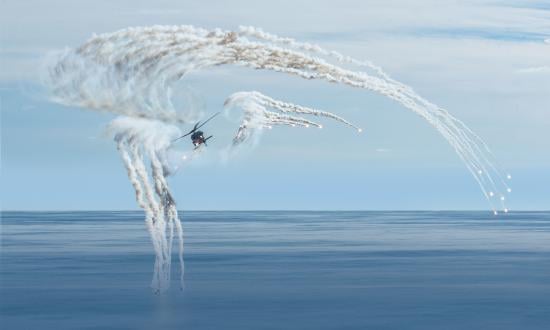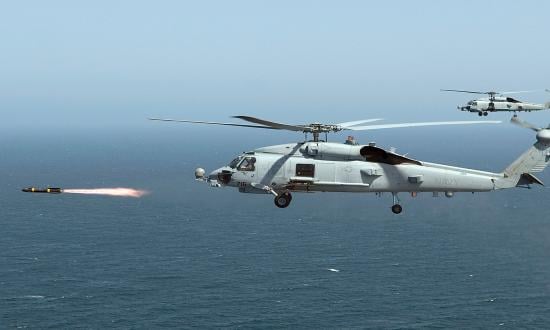MH-60R Seahawk squadrons routinely deploy one- and two-helicopter detachments on single-landing-spot, air-capable ships. In March 2020, Helicopter Maritime Strike Squadron 48 Detachment 7 (HSM-48.7) deployed on board the USS Roosevelt (DDG-80), an independently deployed ship, as a single-aircraft detachment. Over the next seven months, HSM-48.7 conducted operations north of the Arctic Circle, shore-based flights from Rota, Spain, large-scale multinational exercises, and other operations
as needed across the U.S. Sixth Fleet area of responsibility (see Figure 1). Most noteworthy, the detachment conducted antisubmarine warfare (ASW) operations stretching from the Barents to the Mediterranean and Black Seas, supporting operational commanders.
At each opportunity, the detachment demonstrated the MH-60R’s capabilities. Over the course of its deployment, HSM-48.7 flew more than 300 hours and performed more than 450 deck landings. However, as a single-aircraft detachment, it faced many challenges that limited the Seahawk’s availability for tasking.
Stretched Logistics
During the deployment, the aircraft was not mission capable on several occasions because of a lack of supplies, resulting in missed operational opportunities. For instance, while operating in Sixth Fleet, the detachment was forced to wait for two pitch-control rod ends, numerous O-rings, multiple blade-inspection method indicators, a fuel-transfer valve, and an airborne low-frequency sonar kit. Parts were routinely shipped from the United States to various logistics hubs in Europe, where they were repacked with other ship’s parts for delivery to the next port. This often meant the detachment did not receive critical maintenance components until days or weeks later. On several occasions, parts missed the Roosevelt by just hours, prolonging the down time and complicating logistics coordination.
On average, it took 12 days to receive parts from the moment they were ordered. These delays resulted in the aircraft being mission capable only 72 percent of the time and fully mission capable just 33 percent of the time. In other words, the aircraft was not able to fly at all for almost a third of the deployment and was able to operate at its full capability for only a third. In contrast, a two-aircraft detachment historically has at least one mission-capable asset for more than 95 percent of deployment and one fully mission-capable aircraft for more than 75 percent.
There is no excuse for one of the Navy’s most capable maritime assets to be sidelined or degraded for two-thirds of a deployment. On an independently deploying ship, a second aircraft is needed to accomplish the mission. With two aircraft, one can fly if the other is down, and crew can swap parts to keep one helicopter fully mission capable. If HSM-48.7 had had a second aircraft, the detachment would have been able to fly almost double the number of flight hours.
The Navy routinely deploys two-aircraft detachments, but there are circumstances (scheduling, current operations, aircraft availability, etc.) that require single-aircraft detachments. If a single-aircraft detachment is deployed as part of a carrier strike group, it has supplies and the support of other aircraft in close vicinity to keep its aircraft operational. Detachment 48.7, however, was on an independently deployed ship, making the lack of a second aircraft detrimental to the overall mission.
When two-aircraft detachments are not possible, at a minimum single-aircraft detachments need better packup kits. Current kits contain outdated components, some dating back to the 1980s. Having consumables such as O-rings for all parts that require an O-ring would be beneficial. Having a full complement of aircraft electronic components also would aid single-aircraft detachments when these components fail. Space and weight are not a limitation on spare parts; the limitation is availability. When operating alone in remote areas, it is better to have parts on hand than to wait weeks in a less-than-fully capable status.
Even with increased organic parts, there will be times when parts are not on board. As HSM detachments continue to operate in more remote locations such as the Arctic, the supply chain must evolve as well. Single-aircraft detachments in the Arctic require parts closer than thousands of miles away in the Mediterranean. A prepositioned parts cache in the High North would shorten the supply chain and provide for faster replenishment. In addition, the Navy needs to get more creative with parts delivery. Air drops were not uncommon in the past and could prove invaluable if there are capable assets available. Previously, fixed-wing maritime patrol platforms were able to provide this service in Central and South America, for example.
HSM-48.7 executed a successful seven-month deployment and demonstrated the importance of the MH-60R to the most recent National Defense Strategy. The detachment did everything possible to keep the aircraft mission capable, but the limitations of a single aircraft on an Arleigh Burke–class destroyer made this difficult. If the detachment had had a second aircraft, mission capability and participation in multiple major operations and exercises would have been significantly increased. The MH-60R detachment gives the United States and its allies a competitive advantage in a high-end fight. Sidelining such a capable asset by not taking a second helicopter or fully developing a sustainable and responsive logistics chain greatly undercuts that advantage.







